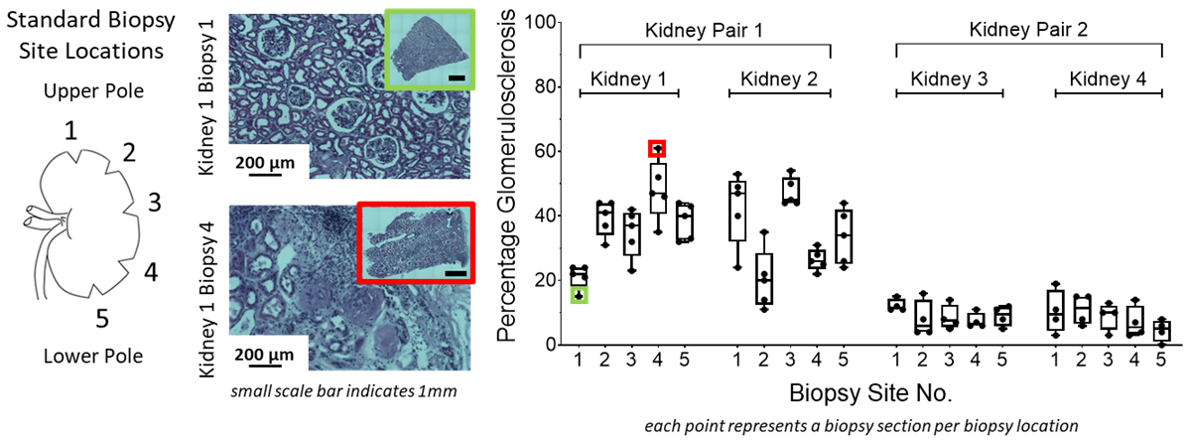Sampling Renal Biopsies in Pre-Clinical Research for Comprehensive Assessment
1Surgery, Yale School of Medicine, New Haven, CT, 2Biomedical Engineering, Yale School of Medicine, New Haven, CT, 3Pathology, Yale School of Medicine, New Haven, CT, 4Immunobiology, Yale School of Medicine, New Haven, CT
Meeting: 2021 American Transplant Congress
Abstract number: 597
Keywords: Biopsy, Histology, Kidney transplantation, Preclinical trails
Topic: Basic Science » Ischemia Reperfusion & Organ Rehabilitation
Session Information
Session Name: Ischemia Reperfusion & Organ Rehabilitation
Session Type: Poster Abstract
Session Date & Time: None. Available on demand.
Location: Virtual
*Purpose: Previous literature has demonstrated that single biopsies are not representative of a whole kidney in clinical assessments. In this study we aimed to design a statistically powered renal biopsy sampling procedure for pre-clinical research that characterizes the variability of glomerulosclerosis in a kidney.
*Methods: Cortical wedge biopsies were obtained from 7 transplant-declined human kidneys in 5 standardized locations. Initial investigation was conducted with 2 kidney pairs. Five sections of 4 μm thickness were spaced at 200 μm along each formalin-fixed biopsy. These sections were stained with H&E and imaged at 20x. The percentage of glomerulosclerosis (%GS) was calculated for each section by counting the ratio of sclerosed glomeruli to total glomeruli. The heterogeneity in %GS within sections, between biopsies, and between paired organs from the same donor was evaluated.
*Results: For Kidney Pair 1 (KP1), there was high variability in %GS calculated within a single biopsy, between biopsy locations, and between paired organs. For Kidney Pair 2 (KP2), there was significantly less variability in %GS for these comparisons. KP1 was from a 36-year-old donor, had a Kidney Donor Profile Index (KDPI) of 32, and was expected to be of superior clinical quality compared to KP2 (age 66 and KDPI 95). Interestingly, KP1 demonstrated higher variability in %GS and had higher overall %GS scores compared to KP2.
*Conclusions: The findings of our study suggest that limited biopsies, taken for clinical evaluation, may be misleading and alternative approaches, such as imaging, may offer additional information. One biopsy section will not yield a representative value of %GS for an entire kidney or kidney pair. In research settings, the quantity of tissue taken from a kidney is inconsequential because the organ is not being transplanted into a patient. Obtaining multiple biopsies from different anatomic positions and scoring several sections per biopsy is one method for calculating a representative value of %GS. This method may also prove useful for other preclinical endpoints such as immunofluorescence staining or transcriptomics, both of which we are currently evaluating. Further investigation is needed to determine how the biopsy sampling procedure should be adjusted for a given research endpoint based on organ donor health or kidney quality.
To cite this abstract in AMA style:
Edwards CM, Albert C, Stern D, Langford J, Day W, DiRito JR, Saltzman WM, Kashgarian M, Pober JS, Tietjen GT. Sampling Renal Biopsies in Pre-Clinical Research for Comprehensive Assessment [abstract]. Am J Transplant. 2021; 21 (suppl 3). https://atcmeetingabstracts.com/abstract/sampling-renal-biopsies-in-pre-clinical-research-for-comprehensive-assessment/. Accessed December 27, 2025.« Back to 2021 American Transplant Congress

